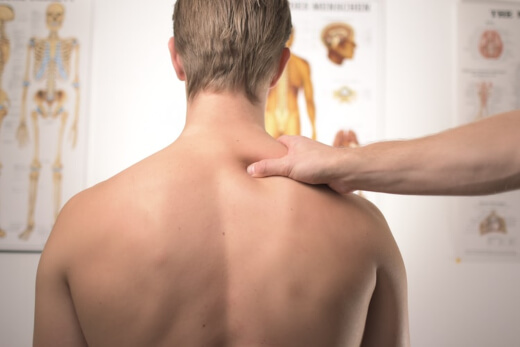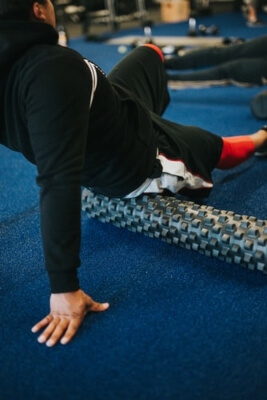If you exercise, you have probably experienced DOMS. It doesn’t matter if you are new to physical training or have been doing it for years. Vigorous workouts can damage muscles causing stiffness and soreness a day or two after exercising.
Many people want to know how to avoid DOMS. It isn’t always avoidable, but there are things that you can do to reduce DOMS and relieve pain.
Knowing how to reduce DOMS can help you have more enjoyable workouts.
What is DOMS?

Delayed onset muscle soreness (DOMS) is a temporary condition that affects the muscles. It causes muscle soreness and aches a day or two after exercising.
DOMS is caused by micro-trauma to the muscle fibers. This damage causes inflammation.
There are also changes in fluid levels near the damaged muscles.
Symptoms of DOMS:
- Muscles are sore to the touch
- Stiffness of muscles and joints
- Reduced range of motion
- Swelling
- Achy muscles
- Temporary loss of muscle strength
How Long Does DOMS Last?
DOMS is a temporary condition that usually goes away within a few days. The length of soreness often depends on the intensity of the workout.
It usually begins within 6 to 8 hours after exercising and peaks around 48 hours.
Relieving Sore Muscles
DOMS is rarely a serious condition. The aches and pains may feel extremely uncomfortable, but they should subside within a few days.
You may not be able to completely get rid of the soreness, but the symptoms are treatable. Knowing how to get rid of muscle pain is essential.
How to help sore muscles:
- A hot bath or shower
- An ice bath
- Ice pack
- Massage
- Alternating hot and cold treatments
- Compression clothing
- Pain relief creams
- Use Epsom salts in your bath
- Foam roller
- Over the counter painkillers

If you are experiencing debilitating pain from DOMS, accompanied by severe cramps, a fever, and/or dark urine, seek medical attention right away.
These symptoms can be serious and may indicate you are experiencing rhabdomyolysis. This condition is linked to extreme muscle breakdown that can damage your kidneys.
Should You Train If You Have DOMS?
DOMS is painful, so should you continue training?
Believe it or not, continuing to exercise can be good for your recovery.
Continuing your intense routine isn’t how to get rid of DOMS. Instead take a walk or participate in a low-impact cardio. This can help loosen and stretch your muscles. Yoga and light stretches are another great way to use your muscles.
If you are a weightlifter, you can continue to lift. However, do not work out the muscles that are causing you pain. Instead, focus on other areas of your body.
Continuing to lift using your damaged muscles can make things worse. Before training, it is important to know the difference between DOMS and an injury.
DOMS will make you feel sore and tight. An injury often has sharp pains. If you believe you have an injury, see a medical professional and avoid exercise.
Preventing Muscle Soreness After Exercise
To prevent sore muscles, it is important to know how to relieve sore muscles after a workout.
Warm-up before you exercise
Before exercising, spend about 5 to 10 minutes doing dynamic stretching. Warming up your body will increase blood flow and loosen muscles.
Cool-down after you exercise
After your workout, spend 5 to 10 minutes of static stretching. Cooling your body down is just as important as warming it up.
Cooling down reduces your breathing and heart rate while lowering your body temperature.
Wear compression clothing
Compression clothing can help fight fatigue and muscle soreness. The tight clothing helps constrict muscles which reduces swelling and fluid buildup.
Don’t overdo it
Doing more than your body can handle can damage your muscles which will lead to DOMS. Fitness doesn’t happen overnight.
Continue to move even on resting days
Even on your days off from working out take a walk or do low-resistance cardio. By keeping moving you are helping to stretch and loosen your muscles. This will help your body recover.

Eat right
Healthy eating is important for your body. And to reach your fitness goals you must get the right nutrients. These nutrients provide energy and reduce the chance of experiencing DOMS.
Protein is critical for building and maintaining your muscles. Try to incorporate foods such as beef, cottage cheese and yoghurt into your diet.
Anti-inflammatory foods will help you avoid inflammation. Try foods such as nuts, seeds, tart cherries, blueberries, green leafy vegetables, and olive oil.
Antioxidant foods can reduce the severity of DOMS. Green tea, Goji berries and kidney beans are a few types to consider.
Magnesium rich foods are natural muscle relaxers. Eat foods such as Spinach, whole grains and avocados.
Omega-3 fatty acids can reduce muscle soreness. Foods high in omega-3 include salmon, tuna, mackerel, and sardines.
Build up the intensity of your workouts
Don’t start off with an intense exercise routine. Slowly increase the intensity while safely building your strength and endurance.
Drink plenty of water
Water removes toxins from your body and keeps you hydrated. Water allows you to build muscle and work out longer.
Get enough sleep
Your body needs sleep to recover. Doctors often recommend around eight hours. When sleeping, your body has an easier time getting oxygen to your muscles.
This allows them to heal faster. It is a good idea to keep a sleep schedule. Go to bed and get up at the same time every day.
This will help your body get an optimal sleep.
Allow Time to Recover
Proper nutrition is just as important as exercise. If you are not eating healthy, you will not be able to meet your physical fitness goals.
Foods that Prevent DOMS
Proper nutrition is just as important as exercise. If you are not eating healthy, you will not be able to meet your physical fitness goals.

Tart cherries
Tart cherries can increase recovery time and decrease muscle pain.
Cottage cheese
Cottage cheese is high in protein. Protein is important for building muscle and can speed up recovery. It also contains leucine which speeds up recovery from pain.
Salmon
Salmon is high in omega-3 fatty acids which are natural anti-inflammatories.
Bananas
Bananas spike insulin and force protein to the muscles.
Coffee
It is believed that drinking coffee before and after a workout can reduce muscle pain.
Watermelon
I-citrulline is the key amino acid in watermelon. It is believed that this amino acid is able to reduce muscle soreness and heart rate.
Watermelon also has high water content that helps hydrate the body.
Eggs
Eggs are a great source of protein. Protein can help reduce the risk of DOMS.
Cinnamon & Ginger
Both cinnamon and ginger are natural anti-inflammatories. They also reduce muscle pain.
Tumeric
Tumeric has antioxidant and anti-inflammatory properties.
Difference between DOMS and Rhabdomyolysis
Sometimes DOMS is confused with rhabdomyolysis. DOMS is a temporary condition that isn’t serious. Rhabdomyolysis is a serious condition.
If you are having trouble peeing, your urine is dark colored, or the soreness doesn’t improve within a few days seek medical attention.
These are all symptoms of rhabdomyolysis. Muscle that are damaged can break down releasing an enzyme called creatine kinase.
Under some circumstances this can be normal. However, high amounts of kinase can lead to rhabdomyolysis. This condition affects the kidneys.
It can even cause kidney failure. Rhabdomyolysis is a very serious condition. Seek medical attention right away if you believe you are experiencing the condition.
It often occurs when someone starts off with too intense of a workout. This is another reason that it is important to slowly build up your workout routine.
Causes of Rhabdomyolysis:
- Too intense of a workout
- Dehydration
- Exercising in extreme heat
- Medications like ibuprofen and acetaminophen

Building a Workout Routine
When you begin a workout routine it is important to start off slowly and work daily to improve. After continuous improvement, you will experience the desired performance that can span your lifetime.
You will also be less likely to experience DOMS. If you do plan on starting a new exercise routine, know how to help sore muscles.
There is a good chance that you may overwork the muscle and need relief. Laying in bed at night and not having any OTC medication on hand can be disappointing.
Plan ahead to be on the safe side. Having heating pads and ice packs are also a good idea.
Our Accredited Exercise Physiologists Can Help
Physical exercise is necessary to keep your body in shape. However, overuse of a muscle can cause pain and discomfort. Don’t let this discourage you from working out.
Keeping active is essential for staying healthy and keeping fit. It is also important when dealing with chronic health conditions.
Our professional Exercise Physiologists can create you an exercise routine that will help you reach your fitness goals while reducing the risk of delayed onset muscle soreness.
At Sydney Sports and Exercise Physiology, we have our exercise physiologists working all over Sydney to make it easier for you. Find an exercise physiologist near you at one of our convenient locations and book an appointment today.
